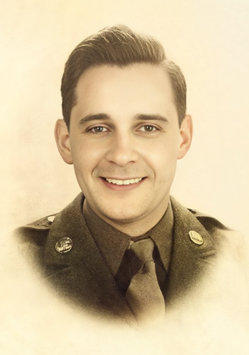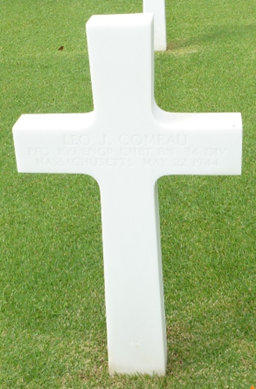
copyright © Wartime Heritage Association
Website hosting courtesy of Register.com - a web.com company
Wartime Heritage
ASSOCIATION
Remembering World War II
Name:
Leo Joseph Comeau
Rank:
Private First Class
Service Number:
31207277
Service:
109th Engineer Combat Battalion,
34th Infantry Division, US Army
Awards:
Purple Heart
Date of Birth:
November 11, 1916
Place of Birth:
Haverhill, Essex County, Massachusetts
Date of Enlistment:
September 30, 1942
Place of Enlistment:
Boston, Suffolk County, Massachusetts
Address at Enlistment:
Haverhill, Essex County, Massachusetts
Age at Enlistment:
25
Height:
5 feet, 8 ½ inches
Complexion:
Dark
Hair Colour:
Brown
Eye Colour:
Brown
Occupation:
Shoemaking cementer
Marital Status:
Single
Religion:
Roman Catholic
Next of Kin:
Larry Comeau (Father), 22 Swasey Street, Haverhill, Massachusetts
Date of Death:
May 22, 1944
Age:
27
Cemetery:
Sicily-Rome American Cemetery, Nettuno, Italy
Grave:
Plot G, Row 11, Grave 62
Leo Joseph Comeau was born in Haverhill, Mass. on November 11, 1916, and was baptized three days later
November 14, 1916, the son of Hilarion ‘Larry’ Raphael Comeau (1875-1946) and Aimee ‘Emma’ Eulalia
(Blinn) Comeau (1884-1926). His father was born in Weymouth, Digby Co., NS, and his mother was born in
Church Point in Clare, also in Digby Co.
His siblings were Louis Joseph Comeau (1905-1982), Dennis Joseph Comeau (1907-1989), Joseph Charles
Comeau (1910-1969), Joseph John Comeau (1913-2005) and Mary Rose Comeau (1919-2005), Joseph
Edward Comeau (1921-2006), and Evelyn Mary Comeau (1925-2016).
Leo’s paternal uncle was Senator Ambroise-Hilaire Comeau (1860-1911), a local merchant, shoemaker, and
Member of the Legislative Assembly in the NS Legislature, and the first Nova Scotia senator of Acadian
descent.
Leo’s parents both immigrated to New England and married in Beverley, Mass. in 1903. Throughout the
1930’s and in 1940, his father was working as a butcher in Massachusetts.
Leo was working as a shoemaking cementer for the Bradford Shoe Company in Hampton, New Hampshire,
when he registered for the US Draft on October 16, 1940, in Haverhill at the age of 23. His brother Joseph
was working as a pounder at the same shoe factory. His brother Edward served in the US Army during WWII
from December 11, 1941, to December 10, 1945.
After enlisting in September of 1942, Leo was assigned to the 109th Engineer Combat Battalion and was
serving with this unit during the Italian Campaign in 1944.
The Battle of Anzio commenced with the Allied amphibious landing known as Operation Shingle on January
22, 1944. and ended on June 4, 1944, with the liberation of Rome. Before Rome, the Allies needed to break
out from Anzio, take Cisterna, and Civitavecchia.
“During the breakout from the Anzio beachhead, the 34th Division’s 109th Engineer Combat Battalion had
the task of opening and maintaining roads to the front lines, clearing lanes through Allied minefields up to
the front, and opening gaps in Allied wire on the front to ensure the safe and uninterrupted passage of
another infantry division, the 1st Armored Division, and the 1st Special Service Force through the 34th
Division’s sector. Work started during the night of May 14th; enemy observation forced the engineer units to
work only after dark. Many of the minefields had been under heavy enemy fire from small arms, machine
guns, and artillery. The mines became extremely sensitive and were likely to detonate under the slightest
pressure. The engineers completed most of the mine clearing during the night of May 20th, but they had to
wait to remove wire and to mark gaps which would disclose the direction of the corps attack. On the night of
May 22nd, the engineers removed the wire from the gaps and marked each lane with tracing tape and
luminous markers. The breakout was a complete success.”
Working under the cover of darkness during the night of May 22, 1944, Private First Class Leo Comeau and 3
other engineers from the 109th Combat Engineer Battalion worked to clear a path for the 34th Infantry
Division’s breakout from Anzio the following day. As the men cut wires and marked safe lanes through
minefields in front of the division, they came under heavy enemy fire. A mortar round killed Comeau and
one of his companions.
Leo Comeau was later interred at the Sicily-Rome American
Cemetery in Nettuno, Italy.
To help honor the members of the US armed forces buried or
memorialized at Sicily-Rome Cemetery, a new visitor center was
dedicated on May 26, 2014. Through interpretive exhibits that
incorporate personal stories, photographs, films, and interactive
displays, visitors may gain a better understanding of this critical
campaign that contributed to the Allied victory in Europe during
WWII. Most importantly, the center connects the visitor with some
of the men and women buried or memorialized there on Italian soil,
including Private Leo Joseph Comeau.
Leo Joseph Comeau


Source:
American Battle Monuments Commission – Leo J. Comeau
American Battle Monuments Commission – Sicily-Rome American Cemetery and Memorial
findagrave
Honorstates.org




- World War I - Menu
- WWI Stories and Articles
- Photos - Yarmouth Soldiers
- Selection of World War I Songs
- WWI Casualties of Yarmouth, NS
- Those Who Served - Yarmouth, NS
- WWI Casualties Digby Co. NS
- WWI Casualties Shelburne Co. NS
- Merchant Mariners (1915) Yarmouth, NS
- Canadian Forestry Corps - Non Yarmouth Birth/Residence Enlistments
- US Draft Registry - Yarmouth NS Born


- World War II - Menu
- WWII Stories and Articles
- Telegraphist Air Gunners
- WWII Casualties of Nova Scotia
- US Casualties with NS Connection
- Far East/Pacific Casualties with NS Connection
- Merchant Navy Casualties Nova Scotia
- Nova Scotia WWII Casualties Holten Canadian War Cemetery
- D-Day Casualties - Nova Scotia
- CANLOAN Program Casualties - Nova Scotia
- Battle of the Bulge Casualties - Nova Scotia
- WWII Casualties Yarmouth NS
- Yarmouth Casualties - RCAF RAF Canadian Army WWII
- Yarmouth Co., Marriages WWII
- Casualties Non-Born/Residents with Connection to Yarmouth Co., Nova Scotia.
- WWII Casualties Digby Co., NS
- Non-Nova Scotian WWII Casualties Buried in Nova Scotia
- WWII RCAF Casualties Aged 16-18
- Brothers/Sisters Who Served - World War II













